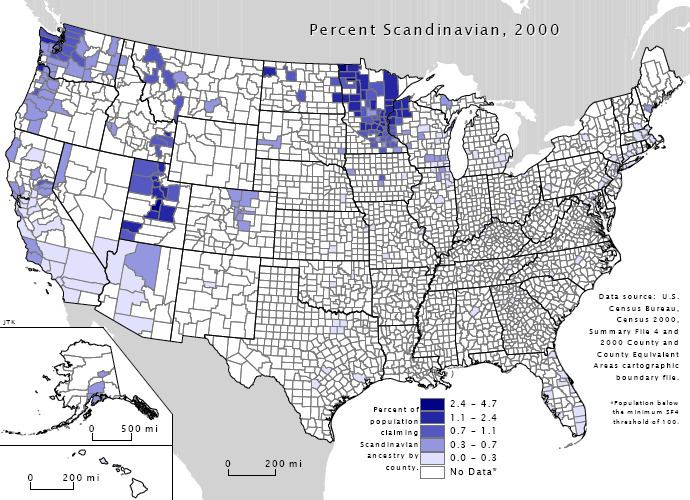Minnesota 1,603,124 Washington 739,043 Illinois 575,991 | California 1,224,541 Wisconsin 728,248 Michigan 403,888 | |
 | ||
Scandinavian Americans or Nordic Americans are Americans of Scandinavian (in the broad sense), or part-Scandinavian ancestry, defined in this article to include:
and people who have reported
making a total of 11,890,524 "Scandinavians".
Finns are not linguistically Scandinavian, with the exception of Swedish-speaking Finns. Americans of Sami descent can be classed as either Norwegian, Finnish or Swedish, however, the Sami are not linguistically Scandinavian either. Despite originating outside of Europe, Greenlandic Americans can be classed as Scandinavian American due to close historical ties with Scandinavia, and because Greenland is one of the three constituent countries of the Kingdom of Denmark.
The highest per capita population of Scandinavian Americans is in North Dakota and Minnesota, and is considerably different on a city level.
There are two definitions of Scandinavia in common use: The geographical Scandinavia includes Norway and Sweden only, as these are the two countries within the Scandinavian Peninsula. The more often used cultural definition of Scandinavia includes Norway, Sweden, Denmark (without Greenland and the Faroese Islands),the semi-independent Finnish territory of Åland and the Swedish-speaking people of Finland (mostly concentrated in Western Finland). The joint ruling of Denmark and Norway from the mid-14th century until 1814, and then the joint rule of Sweden and Norway until 1905, have contributed towards a coherent culture and language. The Scandinavian languages are all descended from old Norse, and unlike Faroese and Icelandic, which have kept more of the old Norse grammar and spelling, the Scandinavian languages have undergone more or less the same simplifications and are mutually intelligible and readable, although the degree of ease with which people understand each other varies depending on country (and region) of origin.
The term Scandinavia is often misused when the term Nordic is meant. The Nordic countries consists of Norway, Sweden, Denmark, Iceland, Greenland (a semi-independent Danish realm), the Faroese Islands (a semi-independent Danish realm), Åland (a semi-independent Swedish-speaking Finnish realm) and Finland. Sometimes also Estonia, Latvia and Lithuania are erroneously included, due to the tiny group of Estonian Swedes in the archipelago of Northern Estonia. Unlike the three linguistically Scandinavian countries, the Nordic countries have languages that are not mutually intelligible and English is often used as a common language when Nordic people communicate. The Nordic countries have some common history, as they have all been invaded by Scandinavians at one time, but even if there are close historical ties, these countries are also more culturally diverse than the Scandinavian countries.
